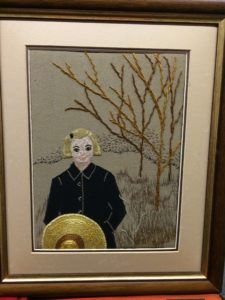 Several years ago, I lay on my back, eyes covered, acupuncture needles protruding from exposed limbs, soft music lulling me into oblivion. Feet warmed by a heat lamp, I sank into the massage table.
Several years ago, I lay on my back, eyes covered, acupuncture needles protruding from exposed limbs, soft music lulling me into oblivion. Feet warmed by a heat lamp, I sank into the massage table.
“Make pillows out of them,” a voice said.
“What,” I responded before realizing it was The Voice in my head.
“Make pillows out of them.”
The last time The Voice spoke to me I was standing at Chicago’s Midway Airport. “Maybe you don’t want to fly to New Mexico,” it had whispered. Had I listened and flown to San Francisco instead of our vacation home in Angel Fire, maybe I wouldn’t have broken my leg the next day? Four years before that, also at Midway Airport, The Voice had spoken with urgency. “Rent a car. Drive to Peoria.” What for, I’d asked? Had I listened, I’d have made it in time for my Mother’s death.
The Voice first spoke to me in 2002 on Maui. Laid off, I attended a manifesting your vision retreat. What to do with my life, I pondered for two weeks? Single and forty, all I knew was I wanted to write my memoir. “Stay, don’t go back to California,” The Voice had said on my last day. Staying on Maui is another story.
Laying on the massage table curious, I contemplated, “make pillows out of them?” Then it dawned on me. The Voice was referring to my mother’s framed stitchery.
My mother, she was something. Self-educated and well read, she delighted in talking circles around her captives. She was equally as snotty about classical music—the only music allowed in our house growing up. I suppose I ought to thank her? Because of her, I can recognize Beethoven, Mozart, Bach or Mahler on the first or second note.
A part of me loved my mother dearly. She introduced me to things I might never have known. But she was an opinionated, silently angry woman. Her college career was dashed when she gave up her scholarship to work so the family could send her brother to Bradley University. He dropped out and joined the navy. When she was forty, she asked my dad if she could go to college. After she died, vulnerable and willing to talk about anything, Dad shared that telling her “no” was his biggest regret.
Mom had raged wildly after Dad said no while I was in high school. Slamming her bedroom door when she felt maligned, swinging Gallo Wine jugs in my face, screaming, “you’re turning me into an alcoholic.” Mom mellowed while I was in college, and after graduation we fell into writing letters and Sunday calls. Then when I was 36, I went home to share news. I’d done what she once told me would kill my father and her—found my birthmother. “I had a bad feeling about your visit,” she’d quipped as I finished telling my search story. We spoke about my birthmother, maybe twice.
I believe my mother both loved me and seethed over me. I did what she’d asked. Gone to college. But I didn’t fall into marriage and children. I left Chicago and moved to California. Later danced wild and free on Maui. As the Alzheimer’s ate away her memory, she lashed out at me. Mad at me for asking her to turn down NPR during a Christmas visit when I was forty-five, she hissed, “You’re a pouty spinster. No wonder you’ve never been married.” Another visit, “the reason you still look young, is because you never had children.” It’s taken years to understand her anger I imagine fueled by jealousy. To realize my life choices that she hadn’t liked were okay. These altercations, her sideways comments, made me thankful for her forgetfulness the last time I saw her in the Alzheimer’s home.
“Who are you?” she asked as I sat across from her in her bedroom.
“A friend,” I said without hesitation.
She cocked her head. I waited. “That’s nice,” she said and went back to kneading the skirt fabric she’d sewn and embroidered.
I smiled at my dad, and shrugged off his glare.
One day after Mom died, I walked out of my office into the kitchen stymied by the direction my search-for-my-birthmother memoir was taking me.
“What’s the matter,” my husband asked me.
“My mother wants to be in my memoir.”
“What makes you think you can write a story about your adoption and not include her?”
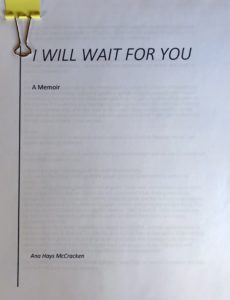 I stuffed my manuscript in my desk drawer. The words I’d written about her were angry. Where were the loving and happy memories?
I stuffed my manuscript in my desk drawer. The words I’d written about her were angry. Where were the loving and happy memories?
After acupuncture, I raced home to the storage closet, and one by one pulled the framed stitchery from cubby holes. Behind streaked glass I saw intricate flowers, abstracts, birds, a girl with a hat, a woolly mammoth. My mother was a talented artist, an expert seamstress, a gifted embroiderer. Women in her stitchery guild marveled at her French knots, how she mingled fabrics, fibers and gold threads. For a time, I had hung her pieces upon walls in my apartments, but in the end, stored them in closets. Her tastes weren’t mine. After Dad died, I’d gathered more of her pieces and attempted pawning them off on cousins. No one wanted them.
In the storage closet, I grabbed a slot-head screw driver, dug it into frames to rip them apart, and pulled fabric stapled to cardboard away from glass. It took hours to remove the staples. The pile of needlework was dusty so I stored them in Ziploc bags, and made an appointment to visit my friend Aida at her atelier. I had purchased several of Aida’s “topper coats”—original designs made from European small-mill textiles, hand-embellished with French and Italian trims, and decorative buttons. If anyone could help me make pillows out of Mom’s stitchery, it was Aida.
Aida’s atelier, located in the Allied Arts Center in Menlo Park, California, is a delightful space. One room with French doors that open out on to a wisteria covered patio. Inside is a feast for the eyes—an array of colorful topper coats hang on two racks, some coats featured on Global Model Forms, two bookshelves stacked with ribbons, boxes of buttons, and a table with stacked rolls of brocade fabrics sometimes organized depending on the day. Aida, whose mother was American and father Syrian, grew up in Damascus. She tells her story in her memoir, Restoring Damascus: with watered down paint. I imagine her flare for mixing textiles, textures and colors stems from her upbringing in Syria.
 Standing with Aida at her table choosing fabrics and embellishments for the pillows, I watched as my mother’s designs took on new life. And at the same time, something stirred inside of me. For four years since her death, I had searched my memory for nice thoughts, anything good about my mother. It was as if an eraser had wiped clean my mother’s slate, leaving only flakes of chalk that fell from my fingers whenever I tried to pick them up. My heart had grown heavy remembering only her soiled pink bath coat, mis-matched slippers, lipstick drawn around her lips before she went to the Alzheimer’s home, and how she and I had screamed at each other across the dining room table the last time she had an inkling I was her daughter.
Standing with Aida at her table choosing fabrics and embellishments for the pillows, I watched as my mother’s designs took on new life. And at the same time, something stirred inside of me. For four years since her death, I had searched my memory for nice thoughts, anything good about my mother. It was as if an eraser had wiped clean my mother’s slate, leaving only flakes of chalk that fell from my fingers whenever I tried to pick them up. My heart had grown heavy remembering only her soiled pink bath coat, mis-matched slippers, lipstick drawn around her lips before she went to the Alzheimer’s home, and how she and I had screamed at each other across the dining room table the last time she had an inkling I was her daughter.
“I don’t like you,” she hissed, flanked by my Dad and brother.
“I don’t like you either,” I snarled, pushing back my chair, grabbing my coat and suitcase, pulling out of the driveway in tears.
How to explain the joy I felt when I returned to Aida’s weeks later to pick up my pillows. The textures. The ribbons. The buttons on reverse sides. Awestruck. Weepy. Aida and I imagined my mother was hanging there in the atelier with us. Admiring her work, and smiling at the fabrics Aida and I had chosen for her embroidery work. I’d like to say all the harsh memories of my mother’s decline faded into the past. But, I can’t. They’re still there waiting for nicer memories to surface and take their place. However, every time a gnarly one tries to highjack my consciousness, I remember the pillows. Each day I make my bed, I touch a pillow, and I think kindly about my mom and the legacy The Voice gave me by suggesting I make pillows out of her embroidery.
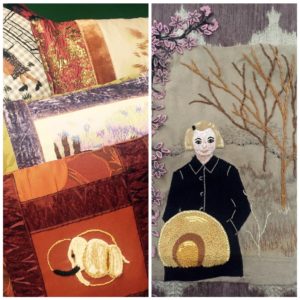 Epilogue: Last summer, I happened upon a needle point piece my mother had made of a church. I imagine this to be the first piece of stitchery she made back in the 60’s. With a trip scheduled to the Bay Area of California, I texted Aida.
Epilogue: Last summer, I happened upon a needle point piece my mother had made of a church. I imagine this to be the first piece of stitchery she made back in the 60’s. With a trip scheduled to the Bay Area of California, I texted Aida.
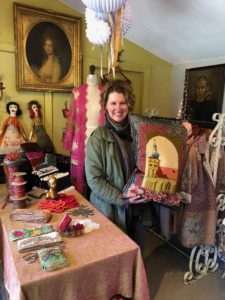 “Hey, you remember me? You repurposed my mom’s embroidery into those gorgeous pillows?”
“Hey, you remember me? You repurposed my mom’s embroidery into those gorgeous pillows?”
“I was thinking about your mom, just today. Look at my embroidery project @aidaandtulip on Instagram. I learned to do free style from your mother, and taught a bunch of women in New York.”
Aida, along with her Syrian-born friend, Tulip, have teamed up to present their colorful, opulent Syrian heritage by designing a Syrian doll collection with the help of sister Syrian refugee guests across the USA. Contributions directly support Syrian women in America by providing an income, independence, and happiness. Check them out on Facebook—Aida and Tulip.
My mother, a history buff who believed Damascus to be the oldest continuously inhabited city in the world, must certainly be proud.


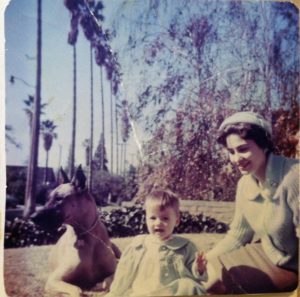
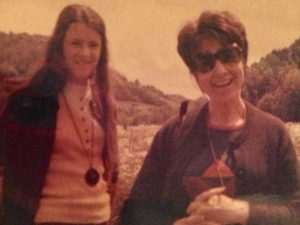



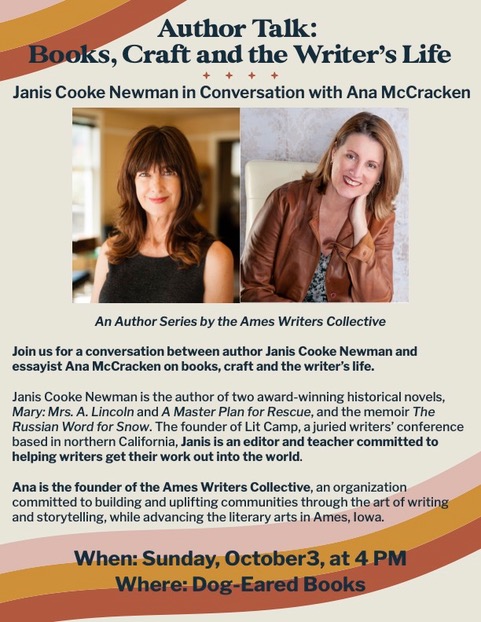

Sad and loving story- great way to share and imprint her memory. Very mov, Ana. I love the pillows – a wonderful legacy. And the dolls are so fun! I’ll look them up on FB.
Hi Susan!
Thank you for reading. I’m glad the story was meaningful for you. I love looking at my pillows everyday and the dolls I bought. They all bring me joy.
Cheers! Ana
a wonderful story. I enjoyed your sharing. You continue to encourage me to write short stories. Thank you.
Best Regards, John
Hi John!
Have you been writing “shorter stories yet?” Thank you for reading.
Happy New Year!
Cheers, Ana
Ana I so loved reading is touching story. Really well written. I guess we all have stories of the past, parents, family members, ect. I was the adventurer in my family so they thought of me as the black sheep. But I was free, and living in Hawaii also. What years were you living on Maui? I was there from 67 to 83.
HI Wyndi!
Apologies for taking “so long” to reply. Thank you for reading my stories. I was on Maui from 2002 to 2004. So long ago already.
Cheers! Ana
I loved reading “Mom’s Embroidery and Syrian Dynasty Dolls.”
Was thinking I was sending you an email when I mistakenly got your web site. You are
definitely a ‘wordsmith.’ I plan to read more after I finally get the email sent to you!!!
Your neighbor, Gwyn
Hi Gwyn!
Thank you for reading “Mom’s Embroidery.” It was fun to write and one of my favorites. I have dolls here in Ames if you’d ever like to see them, as well as pillows made of my mother’s embroidery.
Cheers, Ana